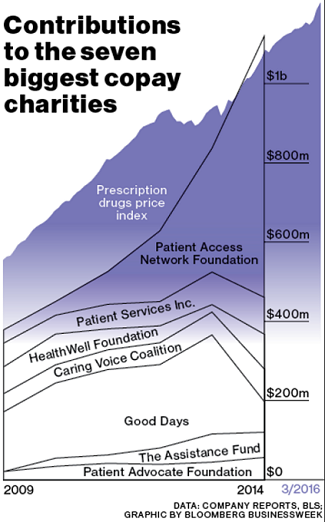Patient copays: the growth mechanism of the pharma industry?
Bloomberg BusinessWeek rakes over charitable copay programs
Call it a Turing/Martin Shkreli ripple effect: Bloomberg BusinessWeek, looking into the mechanics of patient assistance programs (PAPs), has discovered that some pharma companies game the system to boost pharma sales by contributing to charitable programs that assist Medicare patients in obtaining prescriptions. The programs have grown dramatically in recent years--in its (upcoming) May 23 cover story, BusinessWeek calculated that the top seven copay charities firms have gone from $600 million in contributions in 2009 to over $1 billion in early 2016 (see chart). Then, in a highly questionable step, the magazine slapped a "prescription drugs price index" line on the same graph; visually, it looks as if the one can be directly tied to the other. Thus, the headline of the BusinessWeek cover: "Big Pharma is here to help you help them make a bunch of money through charities that make them look good."
"

graphic matches copay contributions with a pharma price index" alignment="left"/>
Exhibit No. 1 in supporting this claim is details from Turing Pharma (obtained through the Congressional investigations of that firm over the past several months) showing that at least one of the charities made a pitch to Turing, pointing out that when the patient's copay costs are covered, the jacked-up prices of its products are paid for by Medicare. Turing ultimately paid at least $1 million into one of the PAP companies, Patient Services, Inc. (PSI). "[T]his much is clear: A million-dollar contribution from a pharmaceutical company to a copay charity can keep hundreds of patients from abandoning a newly pricey drug, enabling the donor to collect many millions from Medicare," the BusinessWeek writers conclude.
So-called copay charities, at least those handling Medicare patients, exist through a well-known loophole in the Medicare system: While conventional copay cards, tied to specific drugs, are banned for Medicare patients as form of improper inducement, charitable contributions for patient assistance that is not tied to a specific drug are not. What Shkreli (and executives at other pharma companies) have realized is that when a copay charity sets up a fund for a relatively unusual condition (which may or may not be a "rare disease" as defined by FDA), and when there's only one or a few drugs for that condition, the money sent to the charity mostly supports the pharma company's drug.
As the article points out, HHS has been onto this gaming of the system. The Chronic Disease Fund (now known as Good Days from CDF) ran into trouble when stock-market short sellers of Questcor Pharmaceuticals questioned the relationship between the charity and Questcor in 2013; in 2014 HHS reviewed its policies (but mostly gave the copay charities a clean bill of health); this year, the Dept. of Justice has issued subpoenas for Jazz Pharmaceuticals and Caring Voice Coalition, another copay charity. In fact, referring back to that BusinessWeek chart, another takeaway is the dramatic success of one of the copay charities, Patient Access Network Foundation, while the others have mostly been puttering along at roughly the same rate except Good Days from CDF, which has been hammered.
Copay dynamics
The basic fallacy in the BusinessWeek article is that rising drug prices are made possible by Medicare copay arrangements--that a $425-billion industry (latest IMS Health figures) depends on the investment of a couple billion dollars in the copay programs. The BusinessWeek writers missed the chance to dig into the dynamics of copay programs for commercial insurance, which--although reliable figures are hard to come by--are 5-10X the scale of the Medicare copays. Industry observers tell Pharmaceutical Commerce that there is hardly a single new drug introduced into the US market without a copay program. Mark Merritt, CEO of the Pharmaceutical Care Management Assn., the trade group of pharmacy benefit managers (PBMs) has long criticized their use, calling them a "classic bait and switch" and asserting that they "induce patients to use higher cost services like brand name drugs when equally effective generics are available."
But the counterarguments are equally valid: generics are prescribed in nearly 90% of all prescriptions (so the copay "action" is mostly restricted to the remaining 10%); some PBMs, some of the time, put one branded drug on a formulary higher than another based on the rebate the pharma manufacturer offers to the PBM (and sometimes the value of that rebate is passed on to the payer, and sometimes it's not); and, at the end of the day, there are some patients better served by a new and probably expensive branded drug than by an old generic one, or one that happens to be offered at a bigger discount to the PBM. And some of those patients need support wherever they can get it.
PBMs have made some blocking moves themselves: the Tufts Center for Drug Development reported on May 10 that PBMs and payers have been expanding their exclusion lists—the groups of drugs that are not reimbursed except under highly restrictive guidelines for most covered lives. According to Tufts, the number of drugs on exclusion lists grew by 65% from 2014 to 2016 at the two largest PBMs (that would be Express Scripts and CVS Health). Also:
- Drug manufacturer rebates to PBMs appear to play a key role in determining exclusion decisions, as do coupon or co-pay offset provisions offered by drug manufacturers to patients.
- Cost-effectiveness does not appear to correlate with exclusion or recommended (covered) status.
- More cost-effective brand name (single source) drugs are not always recommended over other less cost-effective brand name drugs in the same therapeutic class.
The outrageous price hikes Turing, Valeant and other pharma companies have imposed in recent years are raising stronger and stronger criticisms of the industry. PhRMA and others are sticking with their longstanding contention that higher drug prices are the primary support of new therapies still in the labs--but will that argument keep the current system in place?